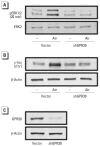G-protein-coupled receptor 30 and estrogen receptor-alpha are involved in the proliferative effects induced by atrazine in ovarian cancer cells
- PMID: 19079715
- PMCID: PMC2599758
- DOI: 10.1289/ehp.11297
G-protein-coupled receptor 30 and estrogen receptor-alpha are involved in the proliferative effects induced by atrazine in ovarian cancer cells
Retraction in
-
Retraction: G-protein-coupled receptor 30 and estrogen receptor-α are involved in the proliferative effects induced by atrazine in ovarian cancer cells. Environ Health Perspect. 116:1648-55.Environ Health Perspect. 2014 Feb;122(2):A42. doi: 10.1289/ehp.11297RET. Environ Health Perspect. 2014. PMID: 24486480 Free PMC article. No abstract available.
Abstract
Background: Atrazine, one of the most common pesticide contaminants, has been shown to up-regulate aromatase activity in certain estrogen-sensitive tumors without binding or activating the estrogen receptor (ER). Recent investigations have demonstrated that the orphan G-protein-coupled receptor 30 (GPR30), which is structurally unrelated to the ER, mediates rapid actions of 17beta-estradiol and environmental estrogens.
Objectives: Given the ability of atrazine to exert estrogen-like activity in cancer cells, we evaluated the potential of atrazine to signal through GPR30 in stimulating biological responses in cancer cells.
Methods and results: Atrazine did not transactivate the endogenous ERalpha in different cancer cell contexts or chimeric proteins encoding the ERalpha and ERbeta hormone-binding domain in gene reporter assays. Moreover, atrazine neither regulated the expression of ERalpha nor stimulated aromatase activity. Interestingly, atrazine induced extracellular signal-regulated kinase (ERK) phosphorylation and the expression of estrogen target genes. Using specific signaling inhibitors and gene silencing, we demonstrated that atrazine stimulated the proliferation of ovarian cancer cells through the GPR30-epidermal growth factor receptor transduction pathway and the involvement of ERalpha.
Conclusions: Our results indicate a novel mechanism through which atrazine may exert relevant biological effects in cancer cells. On the basis of the present data, atrazine should be included among the environmental contaminants potentially able to signal via GPR30 in eliciting estrogenic action.
Keywords: 17β-estradiol; GPR30; atrazine; estrogen receptor; ovarian cancer cells.
Figures











References
-
- Albanito L, Madeo A, Lappano R, Vivacqua A, Rago V, Carpino A, et al. G protein-coupled receptor 30 (GPR30) mediates gene expression changes and growth response to 17beta-estradiol and selective GPR30 ligand G-1 in ovarian cancer cells. Cancer Res. 2007;67:1859–1866. - PubMed
-
- Babic-Gojmerac T, Kniewald Z, Kniewald J. Testosterone metabolism in neuroendocrine organs in male rats under atrazine and deethylatrazine influence. J Steroid Biochem. 1989;33:141–146. - PubMed
-
- Bardin A, Hoffman P, Boulle N, Katsaros D, Vignon F, Pujol P, et al. Involvement of estrogen receptor beta in ovarian carcinogenesis. Cancer Res. 2004;64:5861–5869. - PubMed
-
- Bologa CG, Revankar CM, Young SM, Edwards BS, Arterburn JB, Kiselyov AS, et al. Virtual and biomolecular screening converge on a selective agonist for GPR30. Nat Chem Biol. 2006;4:207–212. - PubMed
Publication types
MeSH terms
Substances
LinkOut - more resources
Full Text Sources
Medical
Research Materials
Miscellaneous

